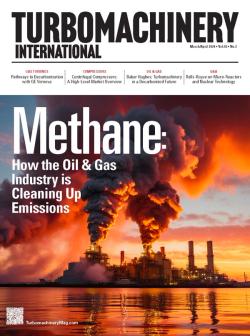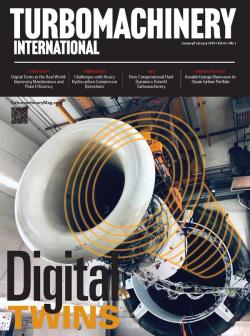
OR WAIT null SECS
© 2024 MJH Life Sciences™ and Turbomachinery Magazine. All rights reserved.
MYTH: EFFICIENCIES AT PIPELINE COMPRESSOR
Over the last two decades there has been increasing pressure from local and federal government regulators as well as environmental groups to reduce the carbon footprint and increase the efficiency of industrial installations in North America.
This also applies to pipeline compressor stations of which there are nearly 8,000 in the U.S. The potential impact of improving their performance could be substantial. Although they represent the most efficient means of transporting energy across transcontinental distances, more than 7% of all natural gas produced in the U.S. is consumed in the pipeline transport and distribution process. Improvement in efficiency could benefit consumer gas prices as well as greenhouse gas emission reduction targets.
The efficiency that can be achieved with modern drivers, such as gas turbines driving centrifugal compressors, is already high, and their reliability contributes to the security of supply. Most compressor stations either use reciprocating compressors driven by gas engines or centrifugal compressors with simple- cycle gas turbines as prime movers. Efficiencies of these drivers range between 30% and 45% based on the type of machine, age, application and operational practices.
This compares well to pulverized coal power plants which operate at between 30% and 40% efficiency. Only the most modern gas turbine combined cycle power plants break the 60% efficiency barrier.
Although the pipeline compressor station infrastructure is not a poor performer overall, there are opportunities for improvement. As an aside, one should not just look at single machine performance, but should consider the optimization of the pipeline as a system, including driver, driven equipment, balance of plant and the pipeline network itself. But that is a topic for another day.
There are several viable, but not always practical, approaches to improving compressor station efficiency. The most obvious choice is to replace old and inefficient machinery that is often maintenance intensive, with modern drivers and compressors.
However, this is not just incredibly capital cost intensive, it may not always provide a substantial performance improvement. Some of the old, slow-speed reciprocating machines that have been operating on U.S. pipelines continue to demonstrate impressive efficiencies. Major improvements could be made on modern reciprocating compressors by developing more efficient cylinder valves and reducing pulsation control losses.
On the other hand, pipeline centrifugal compressor efficiencies have improved over the last 40 years from the low seventies to around 90% efficiency. Similarly, simple-cycle gas turbines have gradually increased from the mid-twenties to above 40%. Even here, additional improvements can be made, mostly at the cost of pressure ratios or intercooling.
But performance improvements appear to have plateaued and future incremental improvements will result in only marginal benefits. As stated earlier, improvements are also achievable by operating the equipment in a smarter way.
Alternatively, replacing gas turbine and engine drivers with electric motors is often proposed as the solution. But that just shifts the efficiency and carbon production problem from the compressor station to often less efficient and much dirtier electric power plants.
An option that has received a lot of recent attention is the use of waste heat recovery in compressor stations. Simple cycle gas turbines are an excellent source of exhaust heat and have for many years been combined with steam cycles to provide additional output power in electric generation plants.
But due to the complexity of waste heat recovery systems, their large footprint, and the need for significant make-up water, they have generally been avoided in the pipeline compression industry. Pipeline operators prefer stations with minimal installed equipment and maintenance requirements due to the remote location of many sites.
Alternatives to steam waste heat recovery systems are novel Organic Rankine Cycle systems which tend to be more compact, but operate a far more complex cycle and require potentially environmentally sensitive chemicals. Recently introduced supercritical CO2 power cycles show great future potential to reduce the size and cost of waste heat recovery but are not yet technically mature. These systems are expected to be commercial within the next three-to-five years.
Since few compressor stations have adequately large and reliable electric utility interconnections, power export is often not practical. The produced energy from the waste heat recovery system can be used to run additional steam turbine or electric motor driven compressors and for parasitic or heating loads within the station.
The industry has also successfully used exhaust heat as process heat, for example for dehydration or CO2 removal. On the other hand, load-following applications, such as pipeline compression, make use of exhaust heat for power or steam generation somewhat complicated.
Thus, it is relatively easy to demand and ponder improvements in efficiency of pipeline compressor stations. But, as is the case with many engineering challenges, the devil lies in the detail. Commercial options exist but they are all painful and costly to implement. Ongoing developments in technologies such as supercritical CO2 cycles for waste heat recovery, improved operating practices, and gains in gas turbine simple cycle efficiency may provide an answer.
Authors
Klaus Brun is the Machinery Program Director at Southwest Research Institute in San Antonio, Texas. He is also the past Chair of the Board of Directors of the ASME International Gas Turbine Institute and the IGTI Oil & Gas applications committee.
Rainer Kurz is the Manager for Systems Analysis at Solar Turbines Incorporated in San Diego, CA. He is an ASME Fellow since 2003 and the chair of the IGTI Oil and Gas Applications Committee.



